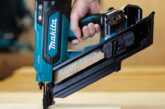
© Oleksandr/Adobe Stock
 Makita explains why tradespeople should consider having a reliable and versatile water pump in their kit and offers advice on what to look for when selecting the best product.
Makita explains why tradespeople should consider having a reliable and versatile water pump in their kit and offers advice on what to look for when selecting the best product.
Winter weather can bring with it the risk of flooded and waterlogged sites, which can slow down progress on site as well as make working conditions more hazardous. Heavy downpours can quickly fill in-progress groundworks with water that must be removed before work can continue. Here it is useful to have a submersible pump to hand. They can be placed in the flooded area, below the water line, to swiftly pump the water into a drain or to soak away on a more suitable area of land. They may also be used to prevent large quantities of water collecting in low areas, such as during heavy rain.
In addition, with one in six properties in the UK at risk of flooding, tradespeople may be called upon to help address flooding in homes and commercial premises. An effective submersible pump can help to quickly clear the flood water so that assessments of the damage can be made, and repairs begun.
Also, for any tradesperson that wants to offer landscaping services to customers, a submersible pump is an essential piece of kit for draining existing ponds and wells and dealing with pooling groundwater.
However, it is important to select the right product and there a several key considerations.
Flowrate
The first and most obvious factor is the capacity of the pump. It is important that it can move a sufficient volume of water to ensure it is cleared swiftly or to stay ahead of incoming water. A capacity of more than 200 litres per minute will be suitable for most on-site tasks.

Maximum pressure
The maximum head pressure that the pump can produce is another key consideration. When draining water from relatively deep areas, such as a well, it is important that the pump can lift the water to ground level and above any obstacles that need to be cleared on the way to the discharge point. It is also necessary if long runs of pipe are being used to remove the water. For example, the Makita PF1110 pump has a maximum submersion depth of 5 metres and creates a head pressure of 10 metres. This means that even at that depth there is still sufficient water pressure to lift the water a further 5 metres or to overcome any resistance within the discharge pipe.
Maximum solid diameter
It is also recommended that professionals look at the type of water that the product is designed to pump. Some will be designed primarily for applications where the water is relatively uncontaminated, such as draining swimming pools or moving irrigation water. These will generally only be able to handle small diameter solid particles in the water – typically around 5mm maximum. This means they are unsuitable for flood water with unknown contamination or water on site that may contain mud, gravel, stones or other debris. Submersible pumps intended for these applications will be able to handle much larger particles, such as the Makita PF1110 pump which can cope with solid particles up to 35mm.
Durability
The nature of how the submersible pump will be used for these applications means it is beneficial to choose a product that is suitably robust. The material used in its construction and the manufacturing quality are important considerations. It is also always recommended that a product from a trusted brand is selected to ensure quality. Furthermore, it is worth looking for a submersible pump with a float switch to stop it running dry when the water level drops below a certain level.

Alternative to submersible pumps
Another solution that may be considered for smaller or shallower areas of water drainage is a pump attachment for a cordless split shaft tool. This can offer a cost effective and versatile option where the multi-functional split shaft is already part of the tradesperson’s kit. For example, the Makita DEAPF400MP attachment, which is compatible with the 18V LXT, Twin 18V LXT (36V) and 40V XGT Makita split shaft tools, has a maximum flowrate of 135 litres per minute and a head pressure of up to 13 metres. While the depth of water it can clear is limited by the length of the shaft and it is only suitable for solid particles up to 5mm, it essentially has no minimum water depth, so it is capable of clearing small areas of water completely.
To find out more about Makita’s range of versatile pumps visit PF1110 – Submersible Drainage Pump (makitauk.com)
For more information on the Makita DEAPF400MP pump attachment visit DEAPF400MP – Split Shaft Water Pump Attachment (makitauk.com)







